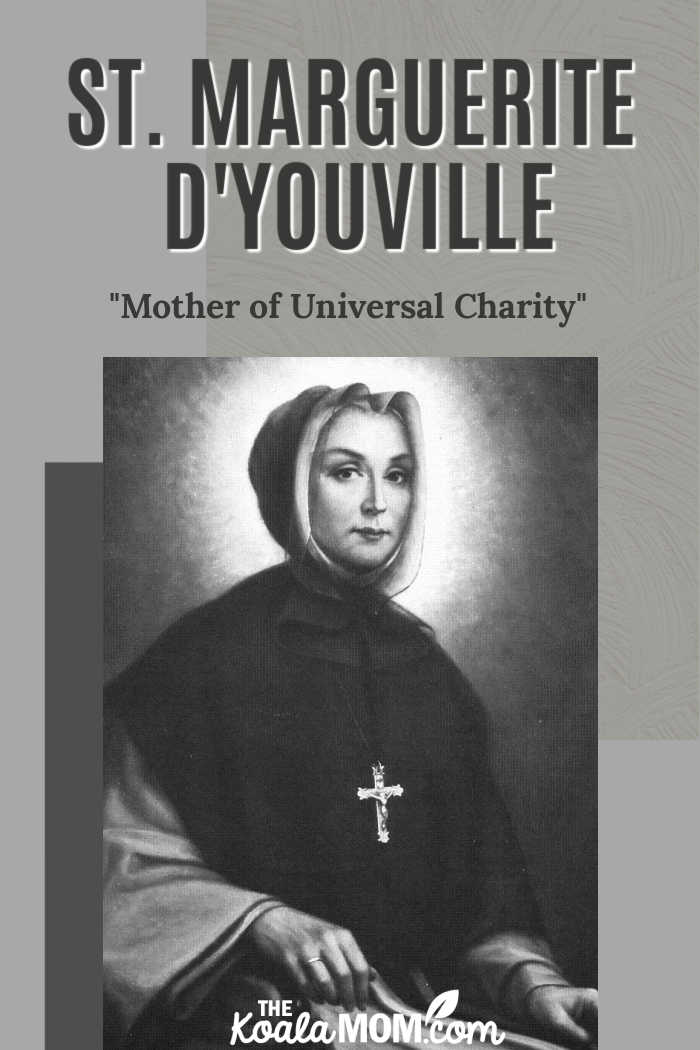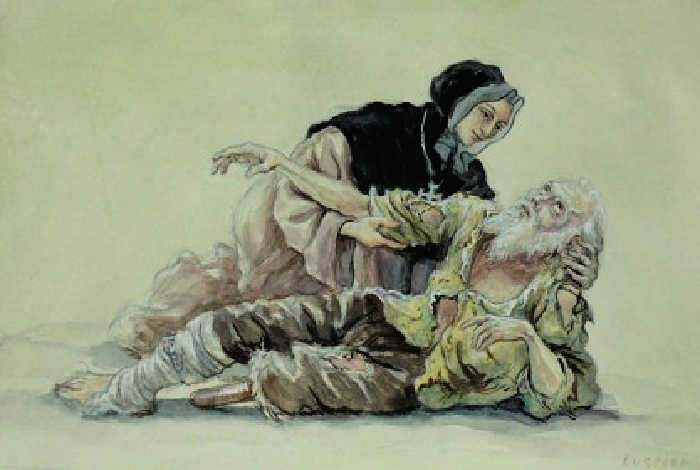One small decision made by another person sent St. Marguerite d’Youville’s life careening off the course she’d planned. Without that decision, her life would have certainly been easier, but Canada would be without the Grey Nuns and the Catholic Church would be without an exemplary saint. From the difficulties of her life, St. Marugerite learned compassion that she poured into others in her community, setting a shining example for the rest of us to follow.

Growing up in New France
Marguerite was the oldest of six children. Her father had been part of a French regiment sent to defend the settlers in New France from the Iroquois. After his military service ended, he remained in New France and married the daughter of the governor of Three Rivers in 1701. They settled in a tiny village called Varennes, just outside of Montreal.
Marguerite’s parents were well-to-do and respected in their community. The first years of Marguerite’s life were likely happy and carefree. However, when she was only seven, her father died fell ill and died. His death left his family in poverty, as the French government took several years to start sending a pension to his widow. Marguerite’s mother planted a large garden and took in sewing and needlework to support her family. Marguerite’s help was required in caring for her younger siblings.
When Marguerite was ten, she was sent to Quebec to attend school at the Ursuline convent, founded by St. Marie of the Incarnation. One of her aunts was a sister at the convent, and she had other family members in Quebec, including her great-grandfather, whose influence had helped get her into school. Marguerite spent two years at school and then returned home to help her mother and let a younger sister have a turn at the convent school.
Marguerite continued to help her mother with her younger siblings, the housework, and the needlework (which was a skill she would have learned at the convent). Despite their poverty, her family would have moved in the best social circles in Varennes and Montreal. As a young woman, Marguerite attended parties and was even courted by a young nobleman. Their wedding date was fixed when the life-changing decision happened.
Marguerite’s Marriage
Seeing that her oldest daughter was getting married, Marguerite’s mother also decided to remarry. Her new husband was the Irish-born son of a doctor, captain of a regiment, and a decade younger than she was. Her family felt she had married below her class, in a hasty wedding at a church far from Varennes. Afraid to be associated with Marguerite’s new stepfather, her fiance’s family broke off their engagement. At age 18, Marguerite lost the love of her life as well as her chance at an easy life as a Montreal noblewoman.
Marguerite’s stepfather moved his new family to Montreal. This change from the small, familiar village of Varennes to the big, crowded city of Montreal must have been hard for Montreal. Her stepfather’s reputation wouldn’t have helped the family to make friends or to move in their former social circle. Despite this, Marguerite found herself courted by the handsome, charming Francois d’Youville. She married him just after her twenty-first birthday. Their marriage register was signed by the most prominent people in Montreal.
The young couple then moved into Francois’s childhood home, where his mother managed everything. Marguerite’s life as a young wife must have been miserable. After her father’s death, her mother had leaned on young Marguerite as a helpmate and companion, giving her great responsibility in the home. In her new home, Marguerite had nothing to do as Madame d’Youville was grumpy and controlling, refusing any help with managing her home.
Francois was an indifferent husband who was often absent, busy with his trading business. He was known to be illegally trading liquor to the Iroquois, which didn’t help Marugerite’s social status. With an unkind mother-in-law and a distant husband, Marguerite turned her attention to her children. Here, she was met with more grief. She gave birth to four children in three years, but only baby Francois lived past his first birthday.
Marguerite dedicated herself to her young son. She gave up wearing jewelry and began to dress simply. She spent more time in prayer, attending daily Mass and going regularly to confession. When Madame d’Youville died, Marguerite was finally able be mistress in her own home. Her second son, Charles, was born. Life seemed about to improve, despite Francois’s frequent trips away from home.
Then Francois returned home, ill. Nursing him must have brought back memories of her father’s illness. Just before Marguerite’s thirtieth birthday, her husband died, leaving her with two sons and a baby on the way.
The Birth of a Saint
The bad news was not over yet. Marguerite soon discovered that her husband’s business was bankrupt. Any inheritance she would have gotten was required to pay his bills. She was allowed to keep her home, but soon after, lost her sixth baby. With two young sons underfoot, Marguerite carried on her husband’s trading business. She proved better in business than her husband had, and soon the thriving business had paid off the last of his debts.
In all these suffering Marguerite grew in her belief of God’s presence in her life and of his tender love for every human person. She, in turn, wanted to make known his compassionate love to all. She undertook many charitable works with complete trust in God, who she loved as a Father. ~ Vatican
Marguerite didn’t let either her business or her housework keep her from her prayers. She continued to wear simple dresses and to spend as much time as she could in prayer. She also helped the poor in her community as she was able. She ensured that her sons were well educated. In 1937, Francois went to Quebec to the seminary founded by St. Francois de Laval. He was followed a few years later by Charles and both were ordained as priests.
With her sons pursuing their educations, Marguerite had more time to spend in helping those around her. She took in a blind woman in her sixties, who had no other home. Her own life of poverty and misfortune had given her deep compassion for those around her. She could no longer overlook the sufferings of the poor, disabled and elderly women she met.
Marguerite’s life exemplifies an important but simple truth: Great things can be done by a combination of God’s grace, immense love and perseverance. The extraordinary thing about her life is that she began where she was, being who she was. Out of that simple condition, like the leaven in the dough, a great and glorious work flourished. ~ Franciscan Media
Founding the Grey Nuns
On December 31, 1937, Marguerite and three companions formed a lay association to help the poor. All four women took vows of poverty, chastity and obedience. This was the beginning, although they didn’t know it then, of the Grey Nuns. Their work began in Marguerite’s home, where they took in and cared for as many needy women as they could. A year later, the moved to a larger home, where they set up a chapel in honour of Jesus. The lower rooms of the house and the attic provided lodgings for women who had nowhere else to live in Montreal.
Despite their good work, Marguerite and her companions faced criticism from those around her. They were nicknamed “les grises,” meaning tipsy women, and accused of getting drunk and illegally selling liquor, as Francois’s husband had. Even in death, his reputation affected her. When a fire destroyed their home in 1745, they had trouble finding a new home as no one wanted to rent to them.
Two years later, Marguerite was asked to take charge of the General Hospital. This was a home for the elderly, poor and disable men of Montreal (those who were sick went to the Hotel Dieu). The General Hospital had been run by monks, but it was deeply in debt. Marguerite’s experience both as a businesswoman and in running a home for women were just what was needed. Under her leadership, the General Hospital took in both men and women and soon paid off its debts.
Marguerite and her sisters took in sewing and mending again to support themselves and the Hospital. Marguerite also invested in a farm and other businesses that would provide the Hospital with an income. The sisters continued to live simply, under a Rule of Life written by Marguerite and her spiritual director. They wore grey habits with a black cincture and became known as the Grey Nuns, making their old nickname respectable.
In 1765, fire once again destroyed Marguerite’s home and work. As she knelt in the ashes of the General Hospital, Marguerite sang the Te Deum, a hymn of praise to God. With her sisters, she found shelter for the Hospital’s residents and rebuilt the Hospital.
Throughout the later years of her life, Marguerite suffered from poor health. Just after founding the Grey Nuns, she experience severe knee pain that often confined her to her bed. Surgery did little to help with her injury. She was ill several times. This didn’t stop her from continuing her work.
Saints deal with plenty of discouragement, plenty of reasons to say, “Life isn’t fair” and wonder where God is in the rubble of their lives. We honor saints like Marguerite because they show us that with God’s grace and our cooperation, suffering can lead to compassion rather than bitterness. ~ Franciscan Media
St. Marguerite’s Death and Legacy
St. Marguerite d’Youville died in December, 1771 of a stroke. She was beautified in 1959 by Pope John XXIII, who called her the “Mother of Universal Charity.” Pope Saint John Paul II canonized her in 1990, after her intercession was attributed for a young woman’s miraculous recovery from leukemia. She is the first native-born Canadian saint.
The Grey Nuns continued to carry on her work and have now served on almost every continent. Today, there are Grey Nuns in Montreal, Ottawa, Quebec and other communities across North America.
Marguerite d’Youville can sympathize with the unfortunate and painful situation of so many orphans, with adolescents worried about the future, with disillusioned girls who live without hope, with married woman suffering from unrequited love and with single parents. But most especially, Marguerite is a kindred spirit with all who have given their lives to helping others.
St. Marguerite d’Youville’s feast day is celebrated on October 16th. She is the patron saint of widows, difficult marriages, and the death of young children.
 Kids can learn about the life and work of St. Marguerite d’Youville in my Canadian Saints Kids Activity Book. Through colouring pages, quotes, word puzzles and other activities, kids will have fun getting to know this amazing Canadian saint. They will also write their own “Rule of Life” and design a postage stamp like the stamp commissioned by Canada Post to commemorate St. Marguerite d’Youville’s work. Canadian Saints Kids Activity Book is available on Amazon and in other Catholic bookstores.
Kids can learn about the life and work of St. Marguerite d’Youville in my Canadian Saints Kids Activity Book. Through colouring pages, quotes, word puzzles and other activities, kids will have fun getting to know this amazing Canadian saint. They will also write their own “Rule of Life” and design a postage stamp like the stamp commissioned by Canada Post to commemorate St. Marguerite d’Youville’s work. Canadian Saints Kids Activity Book is available on Amazon and in other Catholic bookstores.


No Responses Yet